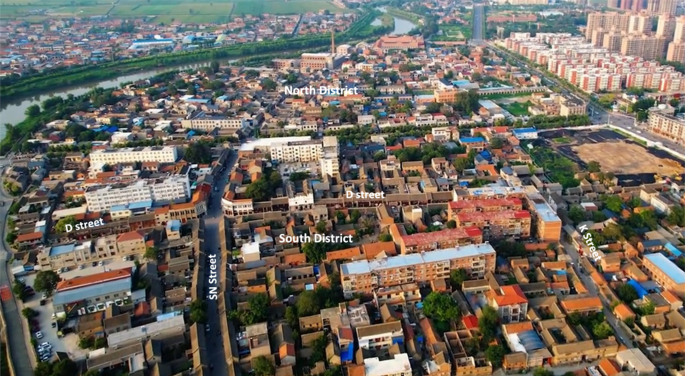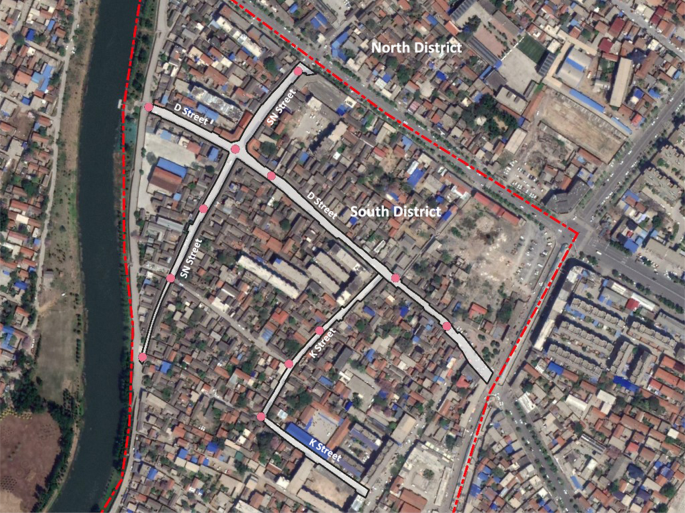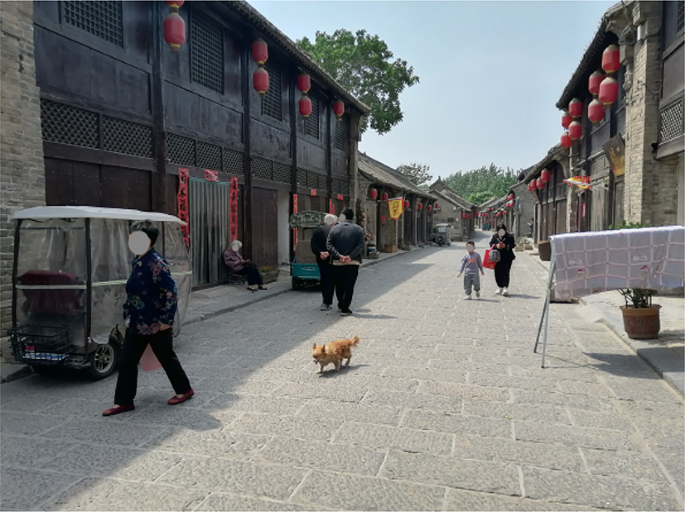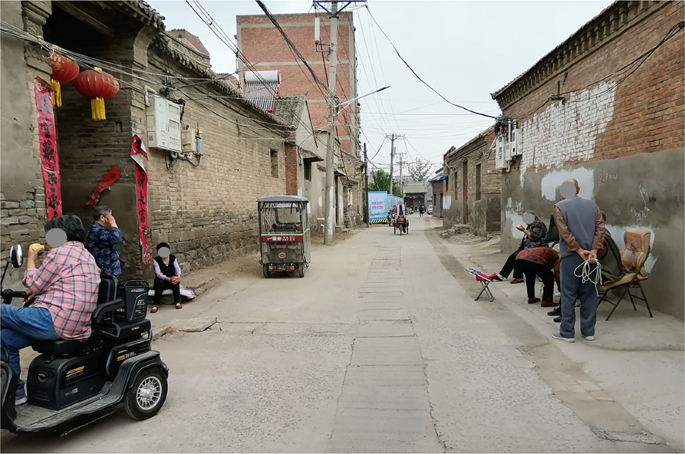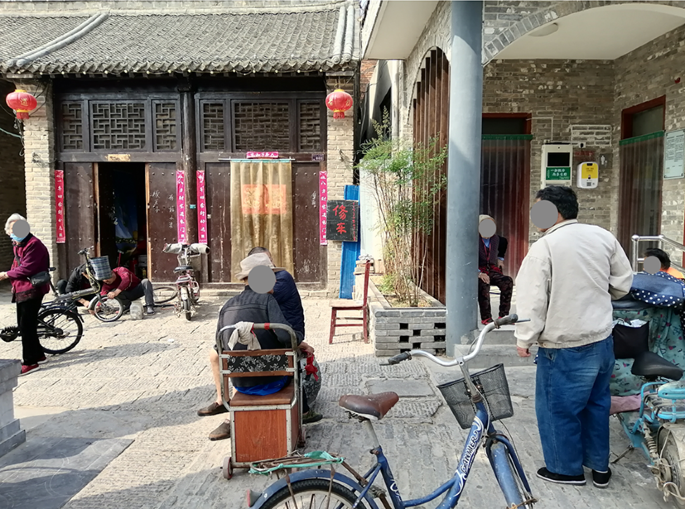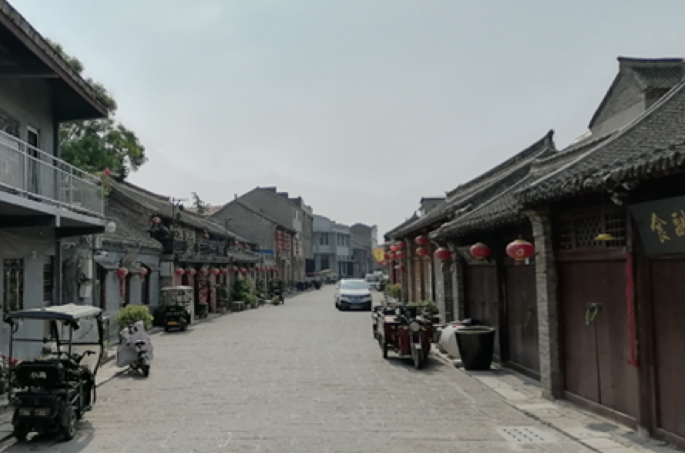Empirical data on older pedestrians’ active travel and neighborhood streets were collected through on-site non-participant observation. It has been defined as a method of data collection via on-site observation. During the observation, researcher observes the street environments, older pedestrians, and their active travel in its natural setting without actively engaging or participating in the activities being studied. Statistical data analyses were conducted to investigate the differences in travel duration.
Research site
Daokou Ancient Town is one of the Nation Cultural Heritage Sites designated bythe National Cultural Heritage Administration in China. It has two districts (north and south districts) separated by a county-level avenue (Fig. 1). Due to restrictions on car traffic, no public transit is provided in the ancient town. People walk, cycle, or drive scooters (electric or motorized scooters for adults) for local transportation.
Aerial photo of the south district of Daokou Ancient Town
Inside the south district, three neighborhood streets are connected with each other and have similar lengths (447, 396, and 387 m for the D, SN, and K Street, respectively) (Figs. 1, 2). With an average width of 6 m, these streets were originally built in Qing dynasty to provide services to visitors and connect local residential alleys. At that time, these streets shaped the major part of the local business system. In recent decades, the D and the SN Street have been used for both commercial and residential purposes, whereas the K Street has transformed into a residential street (Figs. 3, 4, 5, 6). Nine residential alleys (with an average width of 2.6 m) are directly connected to these streets. A total of 47 historic sites can be found along these streets, such as ancient temples and courtyards.
Streets in the south district of Daokou Ancient Town
Place of gathering on the D Street
The D and the SN Street were renovated in 2019 to follow the recent trend of revitalizing ancient towns into characteristic towns for tourism. Stone-brick surface pavement, new drainage systems, and the rebuilding of historic forms on frontier building facades were applied. On the K Street, the most recent renovations were done in 2016, including concrete surface pavement and drainage system updates. Due to the COVID-19 pandemic, these streets weren’t open to tourists at the time of our data collection and provided a good opportunity to investigate local older adults’ active travel on neighborhood streets.
Variables
Investigating the environmental context and the social attributes of active travel in older adults, this research included variables in multiple disciplines, such as environment, behavior, and gerontology. To better understand and organize these variables, the Social Ecological Model (SEM) was applied. This widely accepted model describes a structure of relationships among personal, social, environmental, and behavioral factors [35, 36]. Based on this model, this research grouped the independent variables into three categories: personal, social, and environmental factors.
Focusing on older pedestrians, active travel was accessed by location (street), mode (independent walking or walking with support such as a cane or walker), and duration (the minutes of a pedestrian’s presence on the street during observation). Considering the influence of mobility on travel duration, our data analysis focused on the pedestrians who walked independently without support. Due to limited data availability, the personal factors in research were perceived age (60 years or older), gender, and health, defined as the age, gender, and health status that a person was visually estimated to be on the basis of physical appearance [37].
Two social factors were included in research: social engagement during active travel and the time of active travel. Social engagement was investigated by whether engaging in social interaction (e.g., chatting with people, watching others playing chess or cards, group walking or other group activities) during the travel. Given the importance of the schedule for eating in older adults’ daily living, the time of active travel in research included four dayparts: early-morning (before breakfast), mid-morning (after breakfast), afternoon (after lunch), and evening (after dinner) (Table 1).
Table 1 Older adults’ active travel duration by one-way ANOVA
Regarding the street environments, based on previous research on senior-friendly environments for walking, 20 features in four categories in terms of active-travel promotion were included: typology, motivators, functionality, and safety (Table 2) [16, 38]. Street type by function (commercial, residential, or mixed use), length, and width were included as the factors of street typology. Social-friendly features including the places of gathering and people of the same age group in active travel were included as motivators encouraging active travel. Environmental amenities were also considered as motivators encouraging people to join active travel, such as good landscaping and historic sites of interest to pedestrians. To measure the street’s physical functionality accommodating active travel, the variables of surface evenness, maintenance, seating furniture, restrooms, and signage were included in research. Regarding street safety, the variables of traffic volume, street lighting, security cameras, and safety perception were included.
Table 2 Neighborhood Street Affordance to Older Adults’ Active TravelData collection
Two-level on-site observation was conducted by two researchers in April 2021. The observation collected data on the environment, people, and their behavior. The first level was conducted in the first week of the April and regarding street environmental factors. The second level was conducted in the following two weeks and focused on older pedestrians and their active travel. For data collection, we introduced the research aim, methods, and schedule to the local government via consent letters and phone calls and collected approval. This research was also reviewed and approved by a university-based institutional review board in China.
To collect data on street environments, we used a street investigation tool titled Cat’s Eye. It was supported by geographic positioning systems and computational vision technology and has been widely used in street design and planning projects in China. Data collected by Cat’s Eye has been demonstrated to be reliable [39]. By using this tool, we took digital photos of street view at eye level for every 20–25 m on these streets. A total of 54 street-view photos (18 of the D, 17 of the K, and 19 of the SN) were investigated, including the percentages of greenery, sky, buildings, and street surfaces on the photos. Laser meters (ISO9001 certified) were applied to measure the street environments. Street maintenance and surface evenness were rated by using a 5-point Likert Scale from low to high.
Given the general differences in daily living between weekdays and weekends and the possible influence of weather on active travel, the second-level observations were conducted for six sunny weekdays (two on each street). To represent a typical day, we used seven 30-minute observations: one for the early morning (6:30-7am), two for the mid-morning (9–9:30am and 10–10:30am), three for the afternoon (3–3:30pm, 4–4:30pm, and 5–5:30pm), and one for the evening (7–7:30pm). Three to five spots of observation were selected on each street to ensure the visibility of people and their behaviors (Fig. 2). Focusing on pedestrians with a perceived age of 60 years or older, researchers observed their active travel on the streets without participation or interruption. The information of one’s active travel duration on the street, social engagement, perceived age, gender, and health was recorded. To represent vehicular traffic, the number and types of vehicles (e.g., scooters, motorcycles, and cars) passing through the streets during observation were counted. Both researchers held graduate degrees in environmental design and received training in data collection at a local university. Coding was used by them consistently during the observation to ensure researchers’ similar decisions about similar events on different occasions. All pedestrians on the street were observed and the active travel of those with perceived age older than 60 years were recorded, including those who walk independently or with a cane or walker. The inter-observer agreement was almost perfect (Kappa > 0.8).
Data analysis
Of each street feature, the friendship to older adults’ active travel was individually analyzed and ranked at three levels from A to C, with A the highest. Of the 20 features considered appliable to the friendship, rankings were summarized by street (Table 2). The average durationsof older pedestrians’ active travel on these streets (in a 30-minute observation) were categorized and compared by street, age, gender, health, social engagement, and daypart.
To clarify the differences in active travel duration by street, with attention to the personal and social factors, one-way ANOVA tests were conducted using the Statistical Package for Social Science (version 22.0). Based on the SEM, personal and social variables were analyzed in the first-level ANOVA tests, to identify those associated with significant differences in travel duration (p

